
Classic Buses Profiles
Maidstone and District Leyland Tigers (by Dick Gilbert)
Last updated 15 June 2022

SOME LINKS WITHIN THIS WEBSITE:
Home
Email
Links
THE COMPLETE WEBSITE MENU
Events Diary
Halfcab list
Small-Ads
Classic Irish Buses
Classic Manx Buses
This page is a profile of the fleet of Leyland Tiger single-decker buses and coaches that Maidstone
and District Motor Services operated both before and after the war.
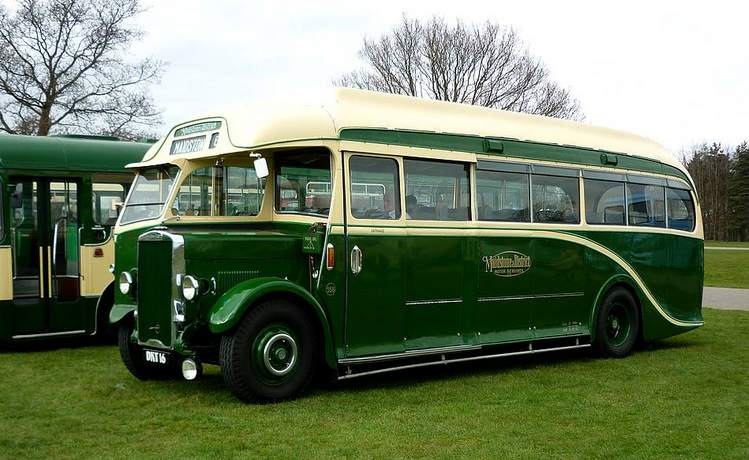
A classic example of the typical Maidstone and District Leyland Tiger coach is pre-war Tiger TS7
CO558 (DKT 16), seen here at the M and D and East Kent bus club 60th anniversary event at Kent County Showground, Detling in
April 2012. Gloriously restored, it sports its post-war Harrington body, and we are fortunate to have it still around today. Its
survival is probably due to it being kept on for boat-carrying duties after its colleagues had been retired, and
a view of the same vehicle in this guise can be seen below. Photo by Dick Gilbert.
INTRODUCTION AND CREDITS
Maidstone and District purchased over 190 Leyland Tigers over three decades. They appeared as buses
and coaches, and in many forms and styles. What follows is an attempt to create a brief history of the type, in the form of
records and images designed to give even the casual reader some impression of the development and classic styling of this
extensive fleet. All batches are arranged in order of delivery.
Maidstone and District Motor Services started by operating four second-hand buses to Chatham in
1908, and by the outbreak of World War 1 the fleet had grown to eleven. In 1922 they built what was to be the first bus station
in the country, at Palace Avenue, Maidstone, and by the end of the decade the company had opened seven depots throughout the area,
from Bexhill to Ashford, and as far afield as Dartford and Sheerness.
A large number of local companies were acquired in the following years, including the absorption in
1933 of Autocar of Tunbridge Wells. In 1935 M and D got into the trolleybus business by gaining control of the Hastings Tramway
Company, a service they maintained until 1959.
A very extensive express coach network was established, linking London with towns all over west
Kent, the Medway towns and parts of Sussex, as well as providing connections between towns throughout that area. A fine fleet of
coaches was acquired for that purpose. During the second world war, its fleet of express coaches had to curtail operations, and
many were converted to ambulances for emergency duties.
Services recommenced in 1946, and new vehicles were purchased to replace the ageing, and sometimes
war-worn pre-war fleet. During the 1950s smart Maidstone and District coaches and single-deck buses could once again been seen
operating regular routes, express services, private hires and excursions, all over the south-east of England and beyond. Some
might say that this was their finest hour.
By the mid 1960s the pre-war fleet had all but disappeared, and halfcab buses of all kinds were
considered dated. New single-deck equipment was arriving, largely in the form of the AEC Reliance, and the proud fleet of
halfcabs had either been scrapped or passed to downstream operators for their twilight years. We are fortunate to have a few
survivors in preservation today. Sadly the Maidstone and District name is no more, having been assassinated by Arriva after more
than 80 years of fine service to the people of Kent and East Sussex.
Maidstone and District vehicle identification changed over the years. Originally only fleet numbers
were used, although certain express coaches seem to have been given the prefix EX. In 1950 coaches were given the prefix CP for
Coach, Petrol, and CO for Coach, Oil (i.e. diesel engined). Similarly single-deck buses became SP and SO. By 1961, as there were
no petrol engined vehicles left in service, it was decided to change SO simply to S, and CO to C. Subsequently prefixes were
dropped altogether, and the system reverted to the use of fleet numbers only.
Owners of pictures, when known, are credited, and their use is much appreciated. However the
photographers of some pictures are not shown on the original photograph, and therefore are not known to me. Whoever they were I
thank them, and if they contact me with their names they will of course be credited. If a rightful owner wishes me to remove any
image, it will be done forthwith. However I hope that photographers (or copyright holders) will permit the use of these fine
pictures in their proper context.
All batches are arranged in order of delivery (including those delivered originally to other
operators).
My thanks to all those who helped me assemble the information, in particular to Ralph Adams and
other sources of the M and D and East Kent bus club, whose data has been invaluable, and to Ian Smith for his help with details
of the transfers to Green Line.
As with my other lists, there are bound to be mistakes, and some relevant information may be
missing so, in order to make it as accurate a reference as possible, I would of course welcome any additions or corrections.
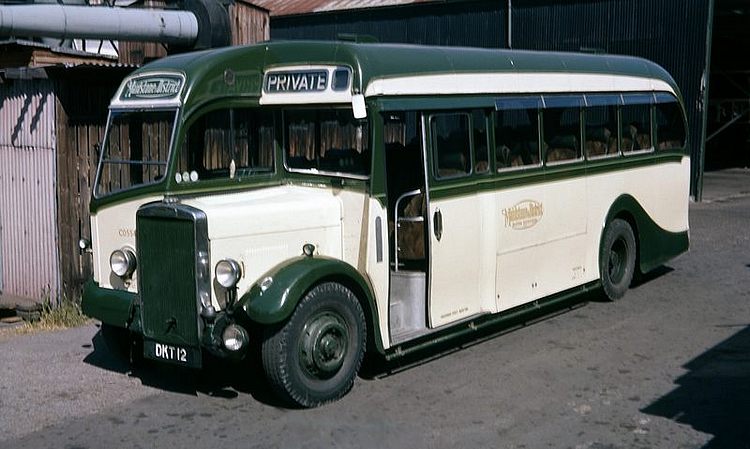
1937 Leyland Tiger TS7 CO554 (DKT 12) photographed at Rye on 23 June 1962 - its last year of
service - by Martin Coull.
FLEET LIST
==========
LEYLAND TIGER TS2 COACHES - 700-704 (Total 5)
Delivered to Redcar 1930
Chassis: Leyland Tiger TS2 (6.8 litre 6-cylinder petrol engines).
Body: Beadle C26D.
Notes: These coaches were jointly purchased by Redcar Services, Tunbridge Wells and Maidstone and
District in 1930. Complete takeover of Redcar's operations took place in February 1935. However the coaches were quickly
transferred to the London Passenger Transport Board in July of the same year, where they became part of the TR class.
- 700 (KR 1166) c/n 60390, delivered 1/30. To LPTB 7/35 as TR37. Withdrawn 1938. Later with Matthews, Rhymney.
- 701 (KR 1167) c/n 60476, delivered 1/30. To LPTB 7/35 as TR38. Withdrawn 1938. Davies, Bridgend 7/39. Morris, Pencoed 4/43 as C25F. Starkey, Tonypandy 7/50 rebodied C31F. Withdrawn 1954.
- 702 (KR 1168) c/n 60788, delivered 2/30. To LPTB 7/35 as TR39. Withdrawn 1937. Reliance Coaches (Taylor), Shillington 6/38. Withdrawn and scrapped 10/51.
- 703 (KR 1169) c/n 60970, delivered 3/30. To LPTB 7/35 as TR40. Withdrawn 1938. Lansdowne Motors, Fleetwood by 12/38, Shaw, Oldham 5/40, Morecambe Motors (Silver Grey) 5/48, K and S Motors, Manchester 3/50, withdrawn 3/51.
- 704 (KR 1170) c/n 60971, delivered 3/30. To LPTB 7/35 as TR36. Withdrawn 1937. Lansdowne Motors, Fleetwood by 12/38. Mee, Pinxton by 1/40, ATO Transport, Pinxton 1/47, Johnson, Rushden by 11/53.
LEYLAND TIGER TS2 BUSES / COACHES - 601-615 (Total 15)
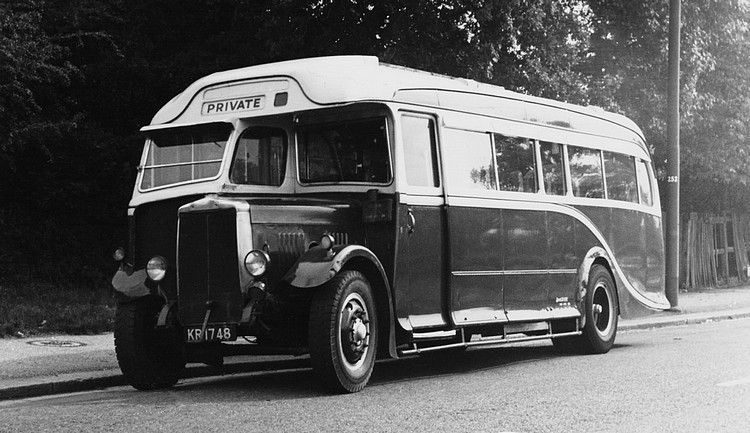
This picture appears to show no. 614 (KR 1748) after withdrawal by Maidstone and District in the
early 1950s, presumably when it was being operated by one of various companies in the London area. Photographer unknown.
Delivered 1930
Chassis: Leyland Tiger TS2 (6.8 litre 6-cylinder petrol engines).
Body: Original body Harrington B31D half-canopy. All rebodied by Harrington as C32F in 1937, and
some original bodies passed to other vehicles, but all then broken up in 1937-38.
Notes; These were known as Pullman saloons, used largely for express services. Originally
designated EX601-615, for express, survivors reclassified as CP in 1950.
- 601 (KR 1735) c/n 61124, delivered 4/30. Rebodied Harrington C32F 3/37, old body scrapped 3/38. To Royal Navy as ambulance 6/41. To Holmes, London N15 3/48. To Horseshoe Coaches, Kempston 11/48. Withdrawn 1/53.
- 602 (KR 1736) c/n 61125, delivered 4/30. Rebodied Harrington C32F 5/37, old body to Dawson (dealer/breaker), London SW9 1/37. Renumbered CP602 7/50. To Clark, Paddock Wood (dealer) 12/52. Seen in Cambridge 5/53.
- 603 (KR 1737) c/n 61126, delivered 4/30. Rebodied Harrington C32F 3/37, old body to Dawson (dealer/breaker), London SW9 1/37. Requisitioned by Army 6/41. Loaned from Admiralty to Belfast Corpn. as No.173 in 1943, with Short B32C body. With Burrows, Wombwell as No.59 Mar 1949. Withdrawn 12/54.
- 604 (KR 1738) c/n 61127, delivered 4/30. Rebodied Harrington C32F 2/37, old body scrapped 3/38. To Royal Navy as ambulance 6/41. To James, High Littletown 5/47. To Pow, Paulton 11/47 to 4/51.
- 605 (KR 1739) c/n 61128, delivered 4/30. Rebodied Harrington C32F 2/37, old body to Dawson (dealer/breaker), London SW9 1/37. Renumbered CP605 7/50. Sold to Parkis (dealer), London 7/52, to Elephant Autos (dealer), London 7/52. In use as caravan, London N17 4/53.
- 606 (KR 1740) c/n 61129, delivered 4/30. Rebodied Harrington C32F 4/37, old body scrapped 6/38. Renumbered CP606 7/50. Sold to Lest-we-Forget Association, Kingston 10/52 as ambulance, still with them 7/56. To St. George's Ambulance and Nursing Service, Worcester Park by 1/58.
- 607 (KR 1741) c/n 61130, delivered 5/30. Rebodied Harrington C32F 4/37, old body scrapped 6/38. Renumbered CP607 7/50. Sold to Parkis (dealer), London 7/52. In use as chicken shed, Ashley Green, Chesham 1/55.
- 608 (KR 1742) c/n 61131, delivered 5/30. Rebodied Harrington C32F 4/37, old body scrapped 6/38. Sold to Kent Police 1/50, for use as mobile police station, and later as B24F personnel carrier based Maidstone.
- 609 (KR 1743) c/n 61132, delivered 5/30. Rebodied Harrington C32F 2/37, old body scrapped 3/38. Requisitioned by Army 6/41. To Broughton, London E2, 8/52.
- 610 (KR 1744) c/n 61133, delivered 6/30. Rebodied Harrington C32F 2/37, old body scrapped 6/38. Requisitioned by Army 6/41. With Roberts, Hounslow (as No.5) 4/48. Roberts and Dickson, Ashford Belle Coaches 6/48. Withdrawn May 1951 (or maybe still with them in 1956).
- 611 (KR 1745) c/n 61134, delivered 6/30. Rebodied Harrington C32F 2/37, old body scrapped 6/38. Used as ambulance during WW2. Renumbered CP611 7/50. Sold to W.Basson (dealer) 3/52. With showman in Maidenhead 7/57.
- 612 (KR 1746) c/n 61135, delivered 6/30. Rebodied Harrington C32F 2/37, old body scrapped 6/38. Requisitioned by Army 6/41. With Crosby and Co., London (non PSV) 8/43. With Warren, Alton 6/47, to Fountain, Cowes 6/47. Withdrawn 2/57, derelict 9/63.
- 613 (KR 1747) c/n 61136, delivered 6/30. Rebodied Harrington C32F 3/37, old body to Dawson (dealer/breaker), London SW9 1/37. Renumbered CP613 7/50. Sold to Parkis (dealer), London 7/52. To Boughton, London E2 7/52, withdrawn 12/53.
- 614 (KR 1748) c/n 61137, delivered 6/30. Rebodied Harrington C32F 4/37, old body scrapped 6/38. Renumbered CP614 7/50. Sold to Parkis (dealer), London 7/52, to Elephant Autos (dealer), London 7/52, to Barnes, London NW11, to Boughton, London E2 c.1952, to Watson, Strood by 8/53, withdrawn 4/54.
- 615 (KR 1749) c/n 61138, delivered 6/30. Rebodied Harrington C32F 4/37, old body to Dawson (dealer/breaker), London SW9 1/37. Requisitioned by Army 6/41. To Hooper, Marston Meysey 9/43, withdrawn 1/53.
LEYLAND TIGER TS2 BUSES / COACHES - 616-635 (Total 20)
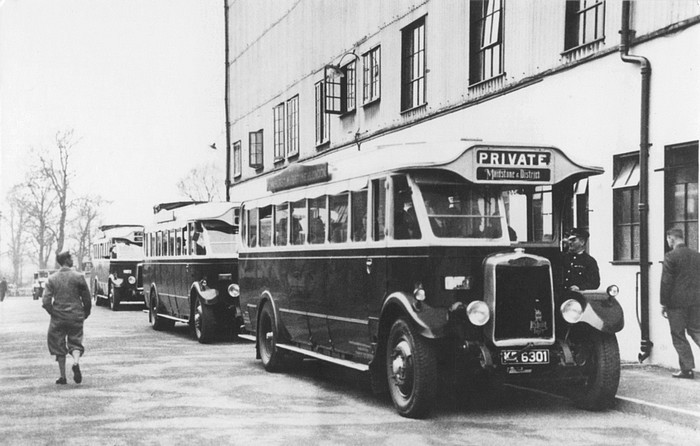
This early 1930s picture of the first of the batch, No.616 (KR 6301), is not only a delight
(along with the gentleman in plus-fours on the left), it is also a puzzle. The board on the side of the roof says ??? (unreadable)
- Maidstone - London so presumably this bus - and the other two behind - are on some express run or excursion up to the city,
but where have they stopped? The substantial building on the right seems to be largely made of corrugated iron, yet it seems to
be guarded by a policeman. Can anyone throw some light on it? Photographer unknown.
Delivered 1930
Chassis: Leyland Tiger TS2 (6.8 litre 6-cylinder petrol engines).
Body: Originally Harrington B31D buses. Some rebodied by Harrington as C32F in 1937.
Notes: Six of these were transferred to the London Passenger Transport Board on its formation in
1933, and became part of their Leyland Tiger TR class. They were subsequently withdrawn in 1938 and replaced in London by T-class
AEC Regals of the 10T10 type.
Coaches still in the M. and D. fleet in July 1950 were redesignated as CP, for Coach, Petrol.
- 616 (KR 6301) c/n 61285 delivered 10/30. To LPTB as TR11 7/33. Transferred to private hire fleet (Old Kent Road) Mar 1938, withdrawn later in 1938. To Lancashire Motor Traders, Salford 5/38, to Raymond (Union Jack), London E2 5/38, last noted April 1945.
- 617 (KR 6302) c/n 61286 delivered 9/30. To LPTB as TR12 7/33, withdrawn 1938. Arlington (dealer) London SW1 11/38. With Valliant, Ealing by 4/39, to Primrose Coaches, Wembley 4/39, then to Valliant, Ealing c.5/39.
- 618 (KR 6303) c/n 61287 delivered 9/30. To LPTB (Green Line) as TR13 7/33, used on Route A (Gravesend - Ascot), withdrawn 1938. To Lancashire Motor Traders, Salford 5/38, to Browning, Cefn Cribbwr 8/38, withdrawn 1/51.
- 619 (KR 6304) c/n 61288 delivered 10/30. To LPTB as TR6 7/33. Later to B30C, then B29C 12/36. Slough garage 1936. Withdrawn 9/37. To H. Lane (dealer), London SW10 9/38. To Valliant Direct Coaches 1/40 and re-registered LMC 978. Withdrawn 3/40 and to military authorities c1940 and later to Ministry of Supply.
- 620 (KR 6305) c/n 61289 delivered 9/30. To LPTB (Green Line) as TR14 7/33, used on Route 'A' (Gravesend - Ascot), transferred to Private Hire fleet (Old Kent Road) Mar 1938, withdrawn later in 1938. Arlington (dealer) London SW1 11/38. With Valliant, Ealing by 4/39, with Pulham, Bourton 6/44, to Kearsey, Cheltenham (No.36) 6/45, withdrawn 12/51.
- 621 (KR 6306) c/n 61290 delivered 10/30. To Harrington C32F 3/37. Original body to Dawson (dealer/breaker), London SW9 1/37. Renumbered CP621 7/50. To Clark (dealer), Paddock Wood 3/53. Showman's caravan 7/53, and still as such 3/57.
- 622 (KR 6307) c/n 61291 delivered 9/30. To LPTB (Green Line) as TR15 7/33, withdrawn 1938. Sold to Morrell (dealer) Leeds 7/38, to Primrose, Wembley 4/39, to Valliant, Ealing c.5/39, later to Hall, Hillingdon.
- 623 (KR 6308) c/n 61292 delivered 9/30. To Harrington C32F 3/37. Original body to Dawson (dealer/breaker), London SW9 1/37. Renumbered CP623 7/50. Sold to Penfold (dealer), Strood 10/52. With showman 5/53, caravan at Borough Green, Kent opposite M and D depot, 1/56.
- 624 (KR 6309) c/n 61293 delivered 10/30. To Harrington C32F 2/37. Original body scrapped 6/38. Renumbered CP624 7/50. Sold to Chaney (dealer), Rainham 10/52. With showman, Palmers Green around 1953. Caravan, Hackney 5/54. Caravan, Godmanchester 4/57.
- 625 (KR 6310) c/n 61294 delivered 9/30. To Harrington C32F 2/37. Original body to Dawson (dealer/breaker), London SW9 1/37. Renumbered CP625 7/50. Sold to Parkis (dealer), London 7/52, to Elephant Autos (dealer/breaker), London 7/52.
- 626 (KR 6311) c/n 61295 delivered 9/30. To Harrington C32F 4/37. Original body to Dawson (dealer/breaker), London SW9 1/37. To Admiralty 6/41, to Royal Navy 6/43, to Davies, Pen-y-Craig 7/48, reregistered HTG 604.
- 627 (KR 6312) c/n 61296 delivered 9/30. To Harrington C32F 4/37. Original body to Dawson (dealer/breaker), London SW9 1/37. Renumbered CP627 7/50. Sold to Parkis (dealer), London 7/52, to Elephant Autos (dealer/breaker), London 7/52.
- 628 (KR 6313) c/n 61297 delivered 10/30. To Harrington C32F 4/37. Original body to Dawson (dealer/breaker), London SW9 1/37. Renumbered CP628 7/50. To Kelson (dealer/breaker) 7/52.
- 629 (KR 6314) c/n 61298 delivered 10/30. To Harrington C32F 4/37. Original body to Dawson (dealer/breaker), London SW9 1/37. Had accident with DH76 20 Mar 1949, and broken for spares at Postley Works (Mandamp;D), Maidstone.
- 630 (KR 6315) c/n 61299 delivered 10/30. To Harrington C32F 4/37. Original body to Dawson (dealer/breaker), London SW9 1/37. To Admiralty 6/41 as ambulance.
- 631 (KR 6316) c/n 61300 delivered 10/30. To Harrington C32F in 2/38, old body sold to Dawson (dealer/breaker) London SW9. Renumbered CP631 7/50. Sold to Parkis (dealer), London 7/52, to Elephant Autos (dealer/breaker), London 7/52.
- 632 (KR 6317) c/n 61301 delivered 10/30. To Harrington C32F 2/37. Original body scrapped 6/38. Renumbered CP632 7/50. Sold to Parkis (dealer), London 7/52, to Elephant Autos (dealer), London 7/52. To Leslie (contractor), London SW8 by 8/53, then with showman in Harpenden 7/54 until at least 6/57.
- 633 (KR 6318) c/n 61302 delivered 10/30. To Harrington C32F in 3/38, old body sold to Dawson (dealer/breaker) London SW9. Renumbered CP633 7/50. Sold to Parkis (dealer), London 7/52, to Boughton, London E2 7/52, withdrawn 11/53.
- 634 (KR 6319) c/n 61303 delivered 10/30. To Harrington C32F in 3/38, old body sold to Dawson (dealer/breaker) London SW9. Renumbered CP634 7/50. Sold to Clark (dealer), Paddock Wood 12/52, to showman 7/53. Scrapped at Newington Salvage, London E11, 10/57.
- 635 (KR 6320) c/n 61304 delivered 10/30. To Harrington C32F in 3/38, old body sold to Dawson (dealer/breaker) London SW9. Renumbered CP635 7/50. Sold to Chaney (dealer), Rainham 10/52. was a caravan in Maidstone 2/55.
LEYLAND TIGER TS2 BUSES / COACHES - 636-650 (Total 15)
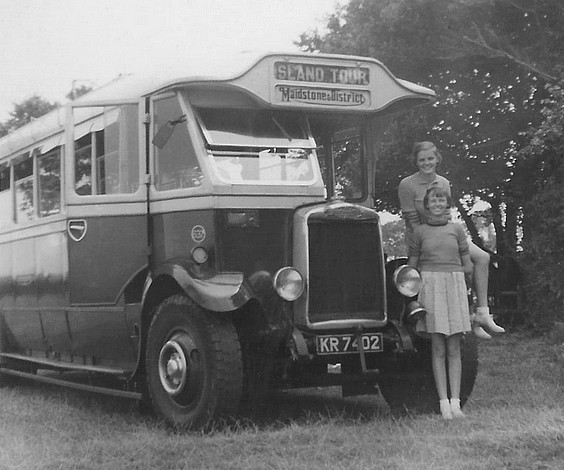
This picture of no. 637 (KR 7402) was kindly sent to me in 2022 by Lisa Holland, She explained
that it was taken in 1937 and shows her mother Kath (seated) and her aunt Bet (standing). Lisa says that the sisters lived in
London at the time so presumably this was taken when they were on holiday, and the destination Island Tour suggests that it might
have been Sheppey. Many thanks to Lisa for the photo.
Delivered Dec 1930 to Jan 1931
Chassis: Leyland Tiger TS2 (6.8 litre 6-cylinder petrol engines).
Body: Harrington B31D bus body. Some rebodied by Harrington as C32F in 1938.
Note: 636-639 probably did not actually enter service until 1931. 640-650 were Pullman Saloons.
Those still in the fleet in July 1950 were redesignated as CP, for Coach, Petrol. All gone by end of 1953.
- 636 (KR 7401) c/n 61317 delivered 12/30. To Harrington C32F in 5/38, old body sold to Dawson (dealer/breaker) London W9. Renumbered CP636 7/50. Sold to Kelson (dealer) 7/52. With a showman, Mitcham 8/56.
- 637 (KR 7402) c/n 61318 delivered 12/30. Fitted with full-length roof rack for band instruments. To Harrington C32F in 6/38, old body sold to Dawson (dealer/breaker) London SW9. Renumbered CP637 7/50. Sold to Clark (dealer), Paddock Wood 3/53. With a showman in 1953, and still in 1957.
- 638 (KR 7403) c/n 61319 delivered 12/30. To Harrington C32F in 3/38, old body sold to Dawson (dealer/breaker) London SW9. Destroyed at Gillingham Depot in air raid 27 Aug 1940.
- 639 (KR 7404) c/n 61320 delivered 12/30. To Harrington C32F in 3/38, old body sold to Dawson (dealer/breaker) London SW9. Renumbered CP639 7/50. Sold to Clark (dealer), Paddock Wood 3/53. Became mobile Evangelical church based at Five Oak Green Tonbridge 7/53, owned by Mr. Friday (and his son). Sides and rear cut away, and floor area extended. At Dargate Motor Museum July 1987. To Hoare, Chepstow, scrapped 9/94.
- 640 (KR 7405) c/n 61321 delivered 1/31. To London Transport 7/33 as TR16. Sold 5/38 to Lancashire Motor Traders, Salford. To Hall Bros., Hillingdon 7/38 (still with them 7/39).
- 641 (KR 7406) c/n 61322 delivered 1/31. Body sold to G. J. Dawson (dealer) 11/37 and rebodied Harrington C32F in 7/38. Renumbered CP641 in 1950. Sold to Clark (dealer), Paddock Wood 3/53, to Uxbridge Queen Coaches, Slough 6/53 as No.7.
- 642 (KR 7407) c/n 61323 delivered 1/31. Body sold to G. J. Dawson (dealer) 11/37 and rebodied Harrington C32F in 5/38. Renumbered CP642 in 1950. Sold to Clark (dealer), Paddock Wood 7/53. Converted to mobile church and seen in Corringham 6/65.
- 643 (KR 7408) c/n 61324 delivered 1/31. Body sold to G. J. Dawson (dealer) 11/37 and rebodied Harrington C32F in 5/38. Renumbered CP643 in 1950. Sold to Chaney (dealer), Rainham, Kent 10/52.
- 644 (KR 7409) c/n 61325 delivered 1/31. Body sold to G. J. Dawson (dealer) 11/37 and rebodied Harrington C32F in 5/38. Renumbered CP644 in 1950. Sold to Clark (dealer), Paddock Wood 3/53. Seen in Cambridge 5/53.
- 645 (KR 7410) c/n 61326 delivered 1/31. Body sold to G. J. Dawson (dealer) 11/37 and rebodied Harrington C32F in 4/38. Renumbered CP645 in 1950. Sold to Parkis (dealer), London 7/52. In Birkenhead 6/53.
- 646 (KR 7411) c/n 61327 delivered 1/31. Body sold to G. J. Dawson (dealer) 11/37 and rebodied Harrington C32F in 4/38. Renumbered CP646 in 1950. Sold to Parkis (dealer), London 7/52.
- 647 (KR 7412) c/n 61328 delivered 1/31. Body sold to G. J. Dawson (dealer) 11/37 and rebodied Harrington C32F in 5/38. Renumbered CP647 in 1950. Sold to Clark (dealer), Paddock Wood 12/52.
- 648 (KR 7413) c/n 61329 delivered 1/31. Body sold to G. J. Dawson (dealer) 11/37 and rebodied Harrington C32F in 5/38. Renumbered CP648 in 1950. Sold to Parkis (dealer), London 7/52. To Boughton, London E2 by 7/54.
- 649 (KR 7414) c/n 61330 delivered 1/31. Body sold to G. J. Dawson (dealer) 11/37 and rebodied Harrington C32F in 9/38. Renumbered CP649 in 1950. Sold to Chaney (dealer), Rainham, Kent 10/52, to Boughton, London E2 by 7/54.
- 650 (KR 7415) c/n 61331 delivered 1/31. To London Transport 7/33 as TR17. To Arlington Motors (dealer, London SW1 11/38. To Valliant, Ealing 4/39.
LEYLAND TIGER TS2 BUSES - 651-675 (Total 25)
Delivered May 1931
Chassis: Leyland Tiger TS2 (6.8 litre 6-cylinder petrol engines).
Body: Original bodywork by Harrington as B31D half-canopy (Pullman Saloons), but rebuilt as B31C in
1937 and downgraded to bus duties. Most were rebodied by Burlingham as utility B34F during 1943-44, later becoming UDP30F with
coach seats.
Notes: All gone by end of 1953.
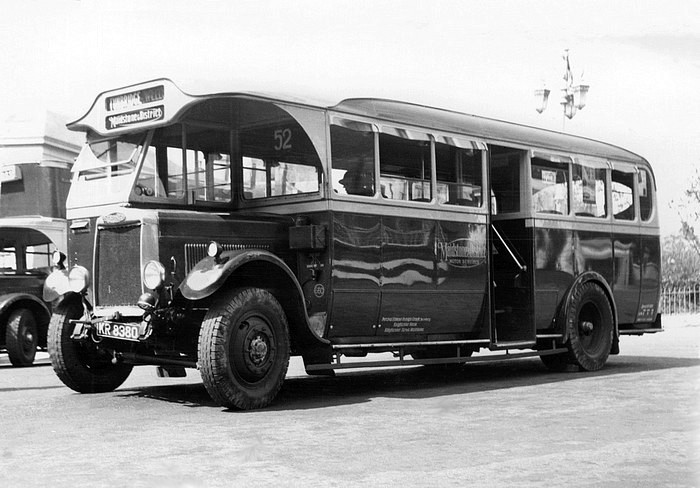
Looking gloriously antique, this is No.660 (KR 8380) taking a breather on route 52, Tonbridge -
Tunbridge Wells - Heathfield - Hastings. The bodywork appears to be the original Harrington handiwork, so this photo is
presumably pre-1944, when 660 was given a Burlingham replacement, and with no wartime signs it must then date from the 1930s. It
appears in fine condition, apart from a cock-eyed number plate. Thanks to Andrew Porter of 5 Tregony Road, Orpington for this
superb photo (ref: 30287).
- 651 (KR 8371) c/n 61332, delivered 5/31. To B31C in 1937. Body sold to Barwicks Garages (dealer) 9/43. Rebodied Burlingham UB34F in 3/44. Renumbered SP651 in 1950. Sold to Clark (dealer), Paddock Wood 7/53.
- 652 (KR 8372) c/n 61333, delivered 5/31. To B31C in 1937. Body sold to Barwicks Garages (dealer) 9/43. Rebodied Burlingham UB34F in 6/44. Later to UDP30F. Renumbered SP652 in 1950. Sold to Clark (dealer), Paddock Wood 7/53. Was a caravan, East Peckham 1954.
- 653 (KR 8373) c/n 61334, delivered 5/31. To B31C in 1937. Body sold to Barwicks Garages (dealer) 9/43. Rebodied Burlingham UB34F in 1/44. Later to UB32F. Renumbered SP653 in 1950. Sold to Chaney (dealer), Rainham, Kent 10/52. Derelict in field nr. Stockbury 1957.
- 654 (KR 8374) c/n 61335, delivered 5/31. To B31C in 1937. Body sold to Barwicks Garages (dealer) 9/43. Rebodied Burlingham UB34F in 5/44. Later to UDP30F. Renumbered SP654 in 1950. Sold to Clark (dealer), Paddock Wood 7/53.
- 655 (KR 8375) c/n 61336, delivered 5/31. To B31C in 1937. Body sold to Barwicks Garages (dealer) 9/43. Rebodied Burlingham UB34F in 6/44. Later to UDP30F. Renumbered SP655 in 1950. Sold to Clark (dealer), Paddock Wood 7/53. With showman, Blackbushe 10/53 and Huntingdon 10/57.
- 656 (KR 8376) c/n 61337, delivered 5/31. To B31C in 1937. Body sold to Barwicks Garages (dealer) 9/43. Rebodied Burlingham UB34F in 2/44. Later to UDP30F. Renumbered SP656 in 1950. Sold to Clark (dealer), Paddock Wood 7/53.
- 657 (KR 8377) c/n 61338, delivered 5/31. To B31C in 1937. Body sold to Barwicks Garages (dealer) 9/43. Rebodied Burlingham UB34F in 5/44. Later to UDP30F. Renumbered SP657 in 1950. Sold to Clark (dealer), Paddock Wood 7/53.
- 658 (KR 8378) c/n 61339, delivered 5/31. To B31C in 1937. Body sold to Barwicks Garages (dealer) 9/43. Rebodied Burlingham UB34F in 12/43. Renumbered SP658 in 1950. Sold to Chaney (dealer), Rainham, Kent 10/52.
- 659 (KR 8379) c/n 61340, delivered 5/31. To B31C in 1937. Body sold to Barwicks Garages (dealer) 9/43. Rebodied Burlingham UB34F in 10/43. Renumbered SP659 in 1950. Sold to Clark (dealer), Paddock Wood 7/53.
- 660 (KR 8380) c/n 61341, delivered 5/31. To B31C in 1937. Body sold to Barwicks Garages (dealer) 3/44. Rebodied Burlingham UB34F in 8/44. Later to UB32F. Renumbered SP660 in 1950. Sold to Clark (dealer), Paddock Wood 7/53. With showman, Blackbushe 10/53.
- 661 (KR 8381) c/n 61342, delivered 5/31. To B31C in 1937. Body sold to Barwicks Garages (dealer) 9/43. Rebodied Burlingham UB34F in 3/44. Later to UDP30F. Renumbered SP661 in 1950. Sold to Clark (dealer), Paddock Wood 7/53.
- 662 (KR 8382) c/n 61343, delivered 5/31. To B31C in 1937. Body sold to Barwicks Garages (dealer) 9/43. Rebodied Burlingham UB34F in 2/44. Renumbered SP662 in 1950. Sold to Chaney (dealer), Rainham, Kent 10/52. With showman, Gravesend 1954, and 1956.
- 663 (KR 8383) c/n 61344, delivered 5/31. To B31C in 1937. Body sold to Barwicks Garages (dealer) 9/43. Rebodied Burlingham UB34F in 11/43. Later to UB32F. Renumbered SP663 in 1950. Sold to Brown (dealer?) 7/52. Canteen with Hammond, Bexleyheath 8/52. In a field, High Halden 7/56.
- 664 (KR 8384) c/n 61345, delivered 5/31. To B31C in 1937. To the Army 7/40. To Canbranis, Whittlesea 6/51, re-registered as EAC 318.
- 665 (KR 8385) c/n 61346, delivered 5/31. To B31C in 1937. Body sold to Barwicks Garages (dealer) 9/43. Rebodied Burlingham UB34F in 12/43. Later to UDP30F. Renumbered SP665 in 1950. Sold to Clark (dealer), Paddock Wood 7/53, later with Robinson, Flishinghurst, to Chris Newman, Maidstone 9/03, in use as a store. ** SURVIVOR ** at Ensignbus, Purfleet 2013. (photo by Chris Stanley, at Ensignbus 3/08). To Chris Pearce, Worthing 3/19.
- 666 (KR 8386) c/n 61347, delivered 5/31. To B31C in 1937. To the Army 6/41.
- 667 (KR 8387) c/n 61348, delivered 5/31. To B31C in 1937. Body sold to Barwicks Garages (dealer) 3/44. Rebodied Burlingham UB34F in 7/44. Later to UDP30F. Renumbered SP667 in 1950. Sold to Clark (dealer), Paddock Wood 7/53.
- 668 (KR 8388) c/n 61349, delivered 5/31. To B31C in 1937. To the Army 6/41.
- 669 (KR 8389) c/n 61350, delivered 5/31. To B31C in 1937. Body sold to Barwicks Garages (dealer) 9/43. Rebodied Burlingham UB34F in 11/43. Renumbered SP669 in 1950. Sold to Clark (dealer), Paddock Wood 7/53.
- 670 (KR 8390) c/n 61351, delivered 5/31. To B31C in 1937. Body sold to Barwicks Garages (dealer) 9/43. Rebodied Burlingham UB34F in 3/44. Later to UDP30F. Renumbered SP670 in 1950. Sold to Clark (dealer), Paddock Wood 7/53.
- 671 (KR 8391) c/n 61352, delivered 5/31. To B31C in 1937. Body scrapped 9/43. Rebodied Burlingham UB34F in 10/43. Renumbered SP671 in 1950. Sold to Clark (dealer), Paddock Wood 7/53.
- 672 (KR 8392) c/n 61353, delivered 5/31. To B31C in 1937. Body sold to Barwicks Garages (dealer) 9/43. Rebodied Burlingham UB34F in 1/44. Renumbered SP672 in 1950. Sold to Chaney (dealer), Rainham, Kent 10/52.
- 673 (KR 8393) c/n 61354, delivered 5/31. To B31C in 1937. Body sold to Barwicks Garages (dealer) 9/43. Rebodied Burlingham UB34F in 4/44. Later to UB32F. Renumbered SP673 in 1950. Used as office at Hastings Coach Station 1/53 - 5/53. Sold to Clark (dealer), Paddock Wood 7/53.
- 674 (KR 8394) c/n 61355, delivered 5/31. To B31C in 1937. Body sold to Barwicks Garages (dealer) 3/44. Rebodied Burlingham UB34F in 8/44. Renumbered SP674 in 1950. Sold to Chaney (dealer), Rainham, Kent 10/52.
- 675 (KR 8395) c/n 61356, delivered 5/31. To B31C in 1937. Body sold to Barwicks Garages (dealer) 9/43. Rebodied Burlingham UB34F in 3/44. Renumbered SP675 in 1950. Sold to Chaney (dealer), Rainham, Kent 10/52. Caravan, Windmill Creek, Isle of Sheppey 1954.
LEYLAND TIGER TS1 COACHES - 676-685 (Total 10)
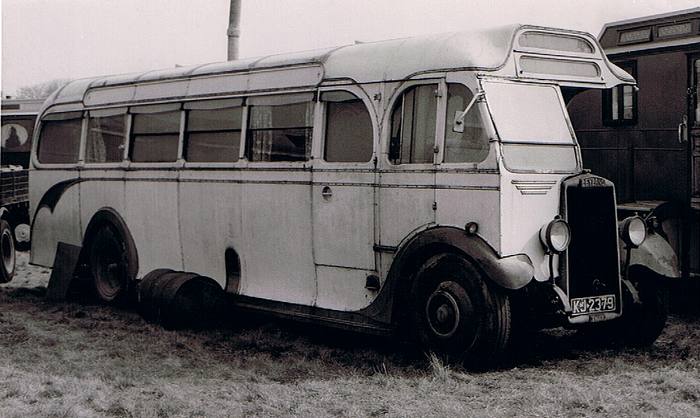
Although this is certainly Maidstone and District Tiger 684 (KJ 2379), the notes on the back of
this photo (of unknown origin) provides more details. It says that the body in the photo is not the original, but is ECW Series
1 no. 4934 which came from United Counties No.47.
Delivered 1931
Chassis: Leyland Tiger TS1
Body: Harrington B31D (Pullman Saloons).
Notes: Last ones sold at end of 1955.
- 676 (KJ 2371) c/n 61906, delivered 8/31. Body sold to Barwicks Garages (dealer) 9/43. Rebodied Burlingham UB34F in 4/44. Renumbered SP676 in 1950. Sold to Chaney (dealer), Rainham, Kent 10/52. Caravan, Mitcham 1956, still there 1958.
- 677 (KJ 2372) c/n 61907, delivered 8/31. Body sold to Roberts (dealer) 3/46. Rebodied Harrington C32F in 7/46. Renumbered CP677 in 1950. Sold to Shoulders (dealer) 12/55.
- 678 (KJ 2373) c/n 61908, delivered 8/31. To the Army 7/40.
- 679 (KJ 2374) c/n 61909, delivered 8/31. Body sold to Roberts (dealer) 3/46. Rebodied Harrington C32F in 7/46. Renumbered CP679 in 1950. Sold to Shoulders (dealer) 12/55.
- 680 (KJ 2375) c/n 61910, delivered 8/31. Body sold to Roberts (dealer) 3/46. Rebodied Harrington C32F in 7/46. Renumbered CP680 in 1950. Sold to Shoulders (dealer) 12/55. Seen. Mobile workshop for Chittenden and Simmons (civil engineering), Crawley 1956, Botley Hill in 1957, still in use 1960.
- 681 (KJ 2376) c/n 61911, delivered 1931. To the Army 7/40.
- 682 (KJ 2377) c/n 61912, delivered 1931. To the Army 7/40.
- 683 (KJ 2378) c/n 61913, delivered 1931. To the Army 7/40. To Harper Bros., Heath Hayes 1943 as no. 26. Rebodied 1949 with 1935 Burlingham C33F body from BRE 477. Scrapped 1955.
- 684 (KJ 2379) c/n 61914, delivered 1931. To the Army 7/40. Seen with showman, Caterham May 1956, probably with an ECW body.
- 685 (KJ 2380) c/n 61915, delivered 1931. To the Army 7/40.
LEYLAND TIGER TS4 COACHES - 686-698 (Total 13)
Delivered 1932
Chassis: Leyland Tiger TS4
Body: Harrington B31C (Pullman Saloons).
Notes: All requisitioned by the Army in July 1940.
- 686 (KJ 5431) c/n 796, delivered 5/32. To the Army 7/40.
- 687 (KJ 5432) c/n 797, delivered 5/32. To the Army 7/40. With Charles Banfield coaches post-war. A.G.Disposals Ltd. (dealer), Northampton 6/53.
- 688 (KJ 5433) c/n 798, delivered 5/32. To the Army 7/40. To Lomas (dealer) 6/51, Lancashire Motor Traders (dealer), Salford 1952. With Showman, Mitcham 1956. Seen with Thurgood body at Odsal 9/62.
- 689 (KJ 5434) c/n 799, delivered 5/32. To the Army 7/40.
- 690 (KJ 5435) c/n 800, delivered 5/32. To the Army 7/40. Austin, Stafford 1947, rebodied with Duple C33F (b/n 42720). Sold 1960, later with showman.
- 691 (KJ 5436) c/n 801, delivered 5/32. To the Army 7/40.
- 692 (KJ 5437) c/n 802, delivered 5/32. To the Army 7/40.
- 693 (KJ 5438) c/n 803, delivered 5/32. To the Army 7/40.
- 694 (KJ 5439) c/n 804, delivered 5/32. To the Army 7/40.
- 695 (KJ 5440) c/n 805, delivered 5/32. To the Army 7/40.
- 696 (KJ 5441) c/n 806, delivered 5/32. To the Army 7/40.
- 697 (KJ 5442) c/n 807, delivered 5/32. To the Army 7/40.
- 698 (KJ 5443) c/n 808, delivered 5/32. To the Army 7/40.
LEYLAND TIGER TS2 BUS - 699 (Total 1)
Delivered to Hucks Bros. June 1932, transferred to M and D in Jan 1933
Chassis: Leyland Tiger TS2
Body: Short B31C
Notes: Acquired with the takeover of Hucks Bros., Burham, Rochester 27 Jan 1933. Requisitioned by
the Army in July 1940.
- 699 (KJ 7440) c/n 61929, delivered to Hucks Bros. 6/32. To Mandamp;D 27/1/33, To the Army 7/40. To Homewood, Kingsnorth 6/48, to J.M. Holloway 8/48, to Marion Coaches Margate late 1948, to Mathieson, Walthamstow 1951.
LEYLAND TIGER TS7 COACHES - 580-600 (Total 21)
Delivered 1935
Chassis: Leyland Tiger TS7 (7.6 litre 6-cylinder petrol engines).
Body: Harrington C31F, but rebuilt to C32F probably before entering service. Most were rebuilt by
Portsmouth Aviation in 1950.
Notes: Five were damaged beyond repair when Gillingham depot was bombed in Aug 1940. Remainder
withdrawn in December 1955.
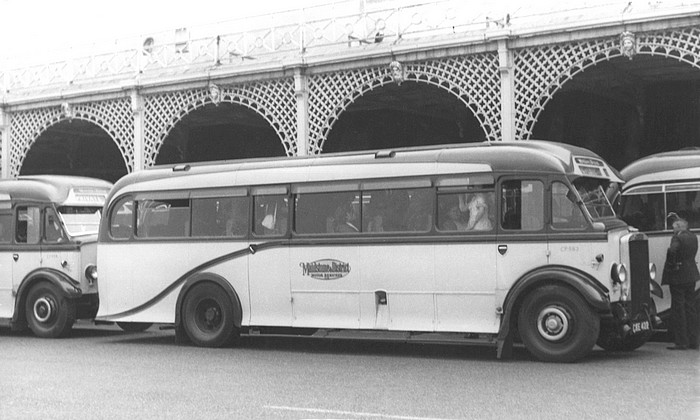
The unmistakable wrought ironwork on Madeira Drive, Brighton provides a decorative backdrop for
no. 583, one of the 1935 Tiger TS7s, with another one behind and maybe more as well. This was some outing! Since the fleet number
above the front mudguard says CP583 (for Coach, Petrol, a designation introduced in 1950), the picture must have been taken
between 1950 and its retirement at the end of 1955, by which time it was a venerable 20 years old. (Photo: Roy Marshall, by
permission of the East Pennine transport group)
- 580 (CKE 419) c/n 6943, new 6/35. Rebuilt by Portsmouth Aviation 6/50. To Shoulders (dealer) 12/55.
- 581 (CKE 420) c/n 6944, new 6/35. Rebuilt by Portsmouth Aviation 4/50. To Shoulders (dealer) 12/55.
- 582 (CKE 421) c/n 6945, new 6/35. Rebuilt by Portsmouth Aviation 4/50. To Shoulders (dealer) 12/55.
- 583 (CKE 422) c/n 6946, new 6/35. Rebuilt by Portsmouth Aviation 5/50. To Shoulders (dealer) 12/55.
- 584 (CKE 423) c/n 6947, new 6/35. Rebuilt by Portsmouth Aviation 4/50. To Shoulders (dealer) 12/55.
- 585 (CKE 424) c/n 6948, new 6/35. Rebuilt by Portsmouth Aviation 7/50. To Shoulders (dealer) 12/55.
- 586 (CKE 425) c/n 6949, new 6/35. Rebuilt by Portsmouth Aviation 5/50. To Shoulders (dealer) 12/55.
- 587 (CKE 426) c/n 6950, new 6/35. Destroyed when Gillingham garage bombed 8/40.
- 588 (CKE 427) c/n 6951, new 6/35. Destroyed when Gillingham garage bombed 8/40.
- 589 (CKE 428) c/n 6952, new 7/35. Rebuilt by Portsmouth Aviation 5/50. To Shoulders (dealer) 12/55.
- 590 (CKE 429) c/n 6953, new 7/35. Rebuilt by Portsmouth Aviation 6/50. To Shoulders (dealer) 12/55.
- 591 (CKE 430) c/n 6954, new 7/35. Rebuilt by Portsmouth Aviation 6/50. To Shoulders (dealer) 12/55.
- 592 (CKE 431) c/n 6955, new 6/35. Rebuilt by Portsmouth Aviation 6/50. To Shoulders (dealer) 12/55.
- 593 (CKE 432) c/n 6956, new 6/35. Fitted with roof rack for band instruments. Rebuilt by Portsmouth Aviation 5/50. To Shoulders (dealer) 12/55.
- 594 (CKE 433) c/n 6957, new 7/35. Destroyed when Gillingham garage bombed 8/40.
- 595 (CKE 434) c/n 6958, new 6/35. Rebuilt by Portsmouth Aviation 4/50. To Shoulders (dealer) 12/55.
- 596 (CKE 435) c/n 6959, new 6/35. Rebuilt by Portsmouth Aviation 5/50. To Shoulders (dealer) 12/55.
- 597 (CKE 436) c/n 6960, new 7/35. Destroyed when Gillingham garage bombed 8/40.
- 598 (CKE 437) c/n 6961, new 6/35. Rebuilt by Portsmouth Aviation 5/50. To Shoulders (dealer) 12/55.
- 599 (CKE 438) c/n 6962, new 6/35. Rebuilt by Portsmouth Aviation 5/50. To Shoulders (dealer) 12/55.
- 600 (CKE 439) c/n 6963, new 7/35. Destroyed when Gillingham garage bombed 8/40.
LEYLAND TIGER TS7 COACHES - 560-579 (Total 20)
Delivered May/June 1936
Chassis: Leyland Tiger TS7 (8.6 litre 6-cylinder oil engines).
Body: Original bodies Harrington C32F. Rebodied by Harrington as C32F half-canopy during 1949-50.
Notes: Renumbered as CO560-579 in 1950.
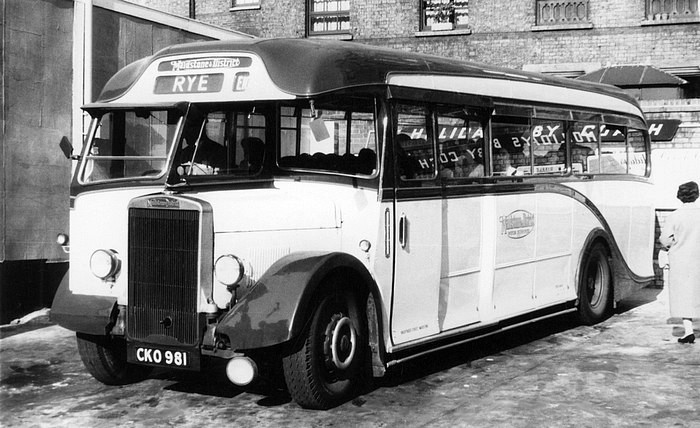
CO578 (CKO 981) on the E10 express service between London and Rye (Garth Wyver points out that it
is seen here at Victoria Coach Station). Its replacement and typical Harrington body dated from 1950 and looks in a fine
condition. This coach soldiered on into the early 1960s, by which time its chassis was around 25 years old. Photo: unknown.
- 560 (CKO 963) c/n 9667. With full-length roof rack for carrying band instruments. To Harrington C32F (b/n 704) 3/50. Sold to Fleet Car Sales (dealer), Dunchurch 10/58. With Tyler, Sandridge 12/58 to 10/60.
- 561 (CKO 964) c/n 9668. To Harrington C32F (b/n 518) 4/49. Sold to Fleet Car Sales (dealer), Dunchurch 10/58. To Diadem, Luton 11/58, withdrawn 9/59.
- 562 (CKO 965) c/n 9669. To Harrington C32F (b/n 712) 3/50. Sold to Fleet Car Sales (dealer), Dunchurch 10/58. With Tyler, Sandridge 12/58 to 10/60. With Passenger Vehicle Disposals (dealer), Dunchurch 6/61, still there 8/61.
- 563 (CKO 966) c/n 9670. To Harrington C32F (b/n 592) 7/49. Sold to Fleet Car Sales (dealer), Dunchurch 10/58. Sold to Libya 11/58.
- 564 (CKO 967) c/n 9671. To Harrington C32F (b/n 512) 3/49. Sold to Fleet Car Sales (dealer), Dunchurch 10/58. Sold to Libya 11/58.
- 565 (CKO 968) c/n 9672. To Harrington C32F (b/n 557) 6/49. Sold to Fleet Car Sales (dealer), Dunchurch 10/58. Alexander and Tatham (dealer), Chesterfield 1/59. McGowan, Kirkmuirhill by 9/59. Cowley (dealer), Salford 10/59.
- 566 (CKO 969) c/n 9673. To Harrington C32F (b/n 611) 9/49. Sold to Fleet Car Sales (dealer), Dunchurch 10/58. To Diadem, Luton 11/58, withdrawn 9/59 and passed to Faulkner (dealer), Fareham. Exported to Libya 11/59.
- 567 (CKO 970) c/n 9674. To Harrington C32F (b/n 765) 5/50. Sold to Fleet Car Sales (dealer), Dunchurch 10/58. C.Davies, Pontlottyn 4/59.
- 568 (CKO 971) c/n 9675. To Harrington C32F (b/n 508) 3/49. Sold to Fleet Car Sales (dealer), Dunchurch 10/58. Sold to Libya 11/58.
- 569 (CKO 972) c/n 9676. To Harrington C32F (b/n 530) 5/49. Sold to Fleet Car Sales (dealer), Dunchurch 10/58. C.Davies, Pontlottyn 4/59.
- 570 (CKO 973) c/n 9677. To Harrington C32F (b/n 680) 1/50. Sold to Fleet Car Sales (dealer), Dunchurch 10/58. Sold to Libya 11/58.
- 571 (CKO 974) c/n 9678. To Harrington C32F (b/n 616) 9/49. Sold to Fleet Car Sales (dealer), Dunchurch 10/58. C.Davies, Pontlottyn 4/59. With Way (dealer), Cardiff 1962.
- 572 (CKO 975) c/n 9679. To Harrington C32F (b/n 681) 1/50. Sold to Fleet Car Sales (dealer), Dunchurch 10/58. With Tyler, Sandridge 12/58 to 10/60. To Saunders Burgess, Waddesdon 10/60. Lumley Saville (dealer), Stratford-upon-Avon 2/62. Reported at garage at Johns Cross 1/67.
- 573 (CKO 976) c/n 9680. To Harrington C32F (b/n 698) 2/50. Sold to Fleet Car Sales (dealer), Dunchurch 10/58. With H. Brooke, Great Houghton by 12/58. Faulkner (dealer), Fareham 10/59. Exported to Libya 10/59.
- 574 (CKO 977) c/n 9681. To Harrington C32F (b/n 699) 2/50. Sold to Fleet Car Sales (dealer), Dunchurch 10/58. To Portsdown Coach Co., Wallington, Fareham 7/59. Faulkner (dealer), Fareham 8/59. Exported to Libya 11/59.
- 575 (CKO 978) c/n 9682. To Harrington C32F (b/n 772) 6/50. Became C575 in 1961. Sold to Fleet Car Sales (dealer), Dunchurch 7/62. To Skey, Sywell by 11/62. With Hadsphaltic (contractor) by 6/65, still in use 8/66.
- 576 (CKO 979) c/n 9683. To Harrington C32F (b/n 668) 12/49. Sold to Fleet Car Sales (dealer), Dunchurch 10/58. To Diadem, Luton 11/58. Holmes, London SE15 7/60. Taylor, London SE1 4/61. With Elm Park Coaches, Romford 8/61.
- 577 (CKO 980) c/n 9684. To Harrington C32F (b/n 662) 12/49. Sold to Fleet Car Sales (dealer), Dunchurch 10/58. C.Davies, Pontlottyn 4/59. With Way (dealer), Cardiff 1962.
- 578 (CKO 981) c/n 9685. To Harrington C32F (b/n 722) 3/50. Became C578 in 1961 (but photo taken in 1962 shows it still as CO578). Sold to Fleet Car Sales (dealer) Dunchurch 10/62. Reclaimed by M and D 11/62. To Transport (Passenger Equipments) Ltd. (dealer), Macclesfield 3/63.
- 579 (CKO 982) c/n 9686. To Harrington C32F (b/n 713) 3/50. Became C579 in 1961. Sold to Fleet Car Sales (dealer), Dunchurch 9/62. Reclaimed by M and D 11/62. To Transport (Passenger Equipments) Ltd. (dealer), Macclesfield 3/63.
LEYLAND TIGER TS7 BUSES - 532-552 (Total 21)
Delivered December 1936
Chassis: Leyland Tiger TS7 (8.6 litre 6-cylinder oil engines).
Body: Harrington B32R half-canopy.
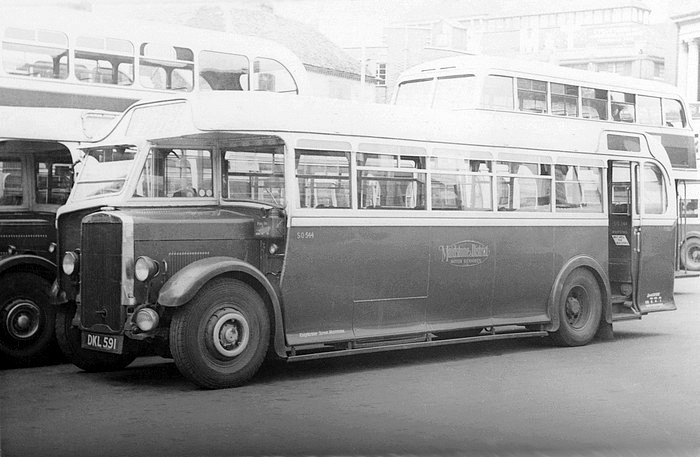
A typical Harrington-bodied single decker bus of the 1930s, SO544 (DKL 591) served Maidstone and
District for more than twenty years. Photo: Roy Marshall, by permission of the Bristol vintage bus group.
Notes: Renumbered SO532-552 in 1950. The running units from three of these buses were used in the
creation of Beadle/Leyland rebuilds CO301-303 (see below). All withdrawn by the end of 1955.
- 532 (DKL 579) c/n 11904. B32F body Renumbered SO532 in 1950. Sold to Passenger Vehicle Disposals (dealer), Dunchurch 8/55. To William Press (contractor), Edmonton, N.London numbered CH5, 5/57 to 7/59. Scrapped by 12/62.
- 533 (DKL 580) c/n 11905. Renumbered SO533 in 1950. Broken up 4/55.
- 534 (DKL 581) c/n 11906. Renumbered SO534 in 1950. Sold to Passenger Vehicle Disposals (dealer), Dunchurch 8/55. To Mitchell (contractor), Peterborough. Returned to PVD, Dunchurch 1/61.
- 535 (DKL 582) c/n 11907. Renumbered SO535 in 1950. To British Transport Commission, British Railways (N. E. Region) 10/54 numbered ELB0101.
- 536 (DKL 583) c/n 11908. Renumbered SO536 in 1950. Broken up 3/55.
- 537 (DKL 584) c/n 11909. Renumbered SO537 in 1950. Broken up 2/55.
- 538 (DKL 585) c/n 11910. Renumbered SO538 in 1950. Sold to Passenger Vehicle Disposals (dealer), Dunchurch 8/55. With Mitchell (contractor), Peterborough 5/56.
- 539 (DKL 586) c/n 11911. Renumbered SO539 in 1950. To British Transport Commission, British Railways (N. E. Region) 10/54 numbered ELB0102. Withdrawn at Bradford Road Motor Engineers' Depot 9/62.
- 540 (DKL 587) c/n 11912. Renumbered SO540 in 1950. Body broken up 1953. Running units used in Beadle/Leyland coach CO301 2/54 (see below).
- 541 (DKL 588) c/n 11913. Renumbered SO541 in 1950. Body broken up 1953. Running units used in Beadle/Leyland coach CO303 3/54 (see below).
- 542 (DKL 589) c/n 11914. Renumbered SO542 in 1950. Body broken up 1953. Running units used in Beadle/Leyland coach CO302 2/54 (see below).
- 543 (DKL 590) c/n 11915. Renumbered SO543 in 1950. Broken up 2/55.
- 544 (DKL 591) c/n 11916. Renumbered SO544 in 1950. Broken up 3/55.
- 545 (DKL 592) c/n 11917. Renumbered SO545 in 1950. Broken up 2/55.
- 546 (DKL 593) c/n 11918. Renumbered SO546 in 1950. Sold to Passenger Vehicle Disposals (dealer), Dunchurch 8/55. With Mitchell (contractor), Peterborough 5/56. Still in use 8/60.
- 547 (DKL 594) c/n 11919. Renumbered SO547 in 1950. Sold to Passenger Vehicle Disposals (dealer), Dunchurch 8/55. With Finnegans (contractor), Sheffield 1956.
- 548 (DKL 595) c/n 11920. Renumbered SO548 in 1950. Sold to Passenger Vehicle Disposals (dealer), Dunchurch 8/55. With Knottler and Heron (contractor) 7/60.
- 549 (DKL 596) c/n 11921. Renumbered SO549 in 1950. Broken up 2/55.
- 550 (DKL 597) c/n 11922. Renumbered SO550 in 1950. Sold to Passenger Vehicle Disposals (dealer), Dunchurch 8/55. To Costain (contractor), London N11 9/55. With Heron (contractor), Fort William 10/58.
- 551 (DKL 598) c/n 11923. Renumbered SO551 in 1950. Broken up 4/55.
- 552 (DKL 599) c/n 11924. Renumbered SO552 in 1950. To British Transport Commission, British Railways (N. E. Region) 10/54 numbered ELB0104. Withdrawn at Bradford Road Motor Engineers' Depot 9/62.
LEYLAND TIGER TS7 COACHES - 553-559 (Total 7)
Delivered June 1937
Chassis: Leyland Tiger TS7 (8.6 litre 6-cylinder oil engines).
Body: Harrington C32F. Some rebodied by Harrington, or rebuilt by Portsmouth Aviation as C32F
during 1949-50. Buses Illustrated magazine for March 1965 (page 104) records some controversy about whether Harrington was
actually involved with the rebuilding, or indeed whether any of the vehicles were actually rebodied at all.
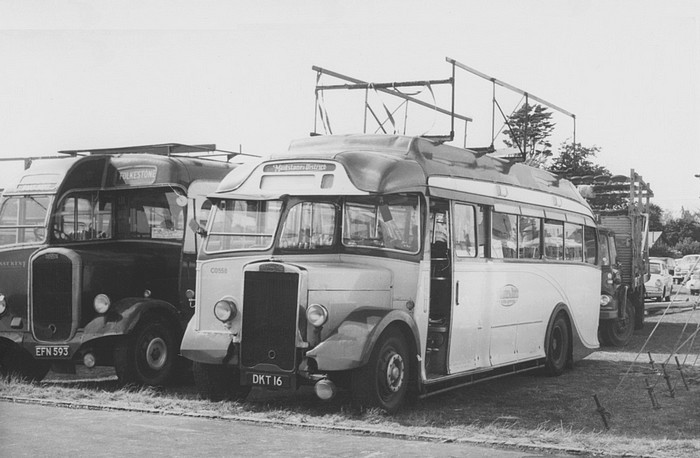
Ageing single-deck buses and coaches (and trucks) were commonly used in the early 1960s to
transport teams to regattas, using boat racks on their roofs. CO558 was relegated to such work at the end of its service years,
and is seen here at Folkestone alongside East Kent Dennis Lancet EFN 593 on the same duty. Curiously DKT 16 should have been
familiar with roof cargo, as it spent its first two years of service carrying brass band instruments in the same way. (Photo: Roy
Marshall, by permission of the Bristol vintage bus group.)
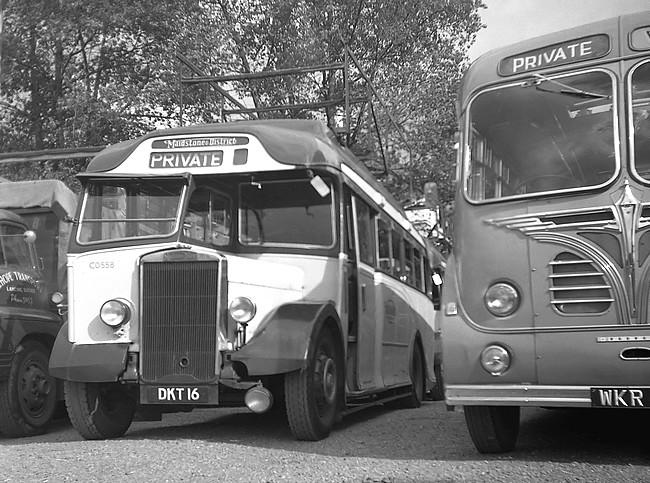
Here is the same vehicle performing the same duty, but this time at Eastbourne in 1963. It was
seen at Greencroft car park, Trinity Place (now a multi-storey), chosen because it was near the sea. Photo by Dick Gilbert.
Allan Haynes kindly sent some additional information: This vehicle has had more owners than I have
had hot dinners, and has suffered significantly from the experience. I owned it briefly in 1995 when I bought it from John
Parslow. It had been stored at the Routemaster Trust's garage in West London, but then all the vehicles were evicted at a week's
notice in order to re-let it to one of the companies involved in the LT privatisation. John rang me in a panic and said: Can you
buy it off me please, I've got nowhere to store it, it's in my engineer's garden in Hampton and it's been raining all week. We
towed it back to my lair in Norfolk and dried it out, then I had a closer look at it and was more horrified than I expected. It
had got very wet in the past but the roof well was now efficiently sealed, but with an awful lot of rotted timber inside, and a
frightening crack in the post behind the passenger door. Frank Elliot (Memory Lane Coaches at Wigan) told me of the day the
engine seized under him on the way to Brighton - number 6 bearing on these engines tends to run dry... So I reluctantly accepted
an offer from the Gibbons boys in Maidstone and let it go.
At some point in the past one of the preservationist owners had seen fit to remove the lovely AEC
style wings that Harringtons had fitted at the rebuild in 1950 and replaced them with pre-war Leyland ones, and moved the autovac
back onto the bulkhead when Harringtons had hidden it nicely under the bonnet, then paint the whole vehicle in the pre-war style
of green with the cream relief. But not the correct pre-war shade of green. The result, sadly, is a total dog's breakfast. I said
earlier rebuild, not rebodying - as I am fairly convinced that it was only rebuilt in 1950. The story I heard many years ago was
that the rebuilds were so expensive that they were shown in the accounts as rebodying. There are two possible ways of proving
this but they are a bit extreme - one way would be to remove the panelling where the original position of the emergency door was -
in front of the rear wheel - to see if the marks from the hinges and the latch are still there. The other would involve tree-ring
dating of the timber frames !
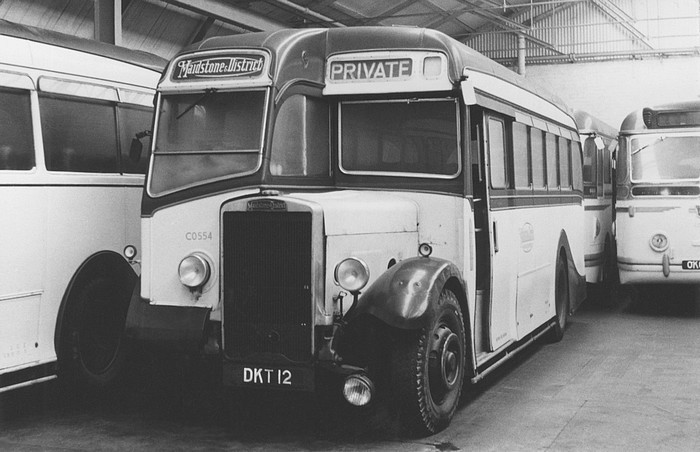
Some of the batch were given half canopy bodies by Harrington in 1950, and CO554 is an example.
This picture probably dates from the early 1960s, as the condition of the old girl (and the others around it) looks a bit battle-
weary, and it may be nearing the end of its days. Photo by kind permission of the Maidstone and District and East Kent bus club.
Notes: Renumbered as CO553-559 in 1950.
- 553 (DKT 11) c/n 13439. Rebodied Harrington C32F (b/n 753) 5/50 and renumbered CO553. Fitted with roof boat-racks around 1958. Renumbered C 553 in 1961. Still active 1962. A report in 1965 suggested that M and D intended to keep this vehicle for preservation. This did not happen, and it went to Hastings and District Multiple Sclerosis society 3/66 with tail-lift and wheelchair access. To C and M Jury (dealer) Hastings, 6/70. To David Hoare, Chepstow 11/70 for preservation. To P.Gray, Ilkley 11/74. To Harold Peers, Otley, Yorks 6/75. Still there (unrestored) in 2000. To Greg Lawson "Yesteryear Coaches" 2017 ** SURVIVOR **.
- 554 (DKT 12) c/n 13440. Worked for Samuelsons New Transport, London SW1 from 2/38 to 3/47. Body rebuilt by West Nor Aircraft Sheet Metal Works, including new seating 1947. Rebodied Harrington C32F b/n 773 (halfcab) 6/50. Renumbered C554 in 1961. Withdrawn 1962. To Fleet Car Sales, Dunchurch 10/62, returned to M and D 11/62. To Transport (Passenger Equipments) Ltd., Macclesfield 3/63. To C.Davies, Pontlottyn 1963. Scrapped 9/64.
- 555 (DKT 13) c/n 13441. To Samuelsons New Transport, London SW1, Feb 1938 as Harrington C32F, withdrawn c.1943 and possibly to military as ambulance, then Ministry of Supply. To Hardings, Birkenhead re-reg as BG 9065, number 24, later 19. Withdrawn 1/54, then reinstated 5/55 as C33F. Withdrawn again 11/55.
- 556 (DKT 14) c/n 13442. Rebodied Harrington C32F (halfcab) (b/n 568) 6/49. Renumbered CO 556 in 1950. To Fleet Car Sales (dealer), Dunchurch 10/58. To Tyler, Sandridge 12/58, still in use 10/60.
- 557 (DKT 15) c/n 13443. Rebodied Harrington C32F (b/n 540) 7/49. Renumbered CO 557 in 1950. To Fleet Car Sales (dealer), Dunchurch 10/58. Exported to Libya 11/58.
- 558 (DKT 16) c/n 13444. On contract to BICC until 1939 for their staff brass band. Had full length roof rack for carrying band instruments. Rebodied Harrington C32F (half canopy) (b/n 762) 5/50 and renumbered CO558. Renumbered C558 in 1961. Canoe racks fitted on roof around 1958. Donated to Norman Day, Historic Commercial Vehicle Club, for preservation 11/64. To C.D.Lovelock and T.L.Murphy, Hollingbourne (later Ashford) 2/68. To Ted Heslop, Hexham 1976. To N. W. Transport Museum. To Rob Gibbons, Maidstone by 1999. ** SURVIVOR **.
- 559 (DKT 17) c/n 13445. Rebodied Harrington C32F (b/n 673) 5/50 and renumbered CO 559. To Fleet Car Sales (dealer), Dunchurch 10/58.
LEYLAND TIGER TS8 BUSES - SO700-708 (Total 9)
Delivered May-June 1938
Chassis: Leyland Tiger TS8 (8.6 litre 6-cylinder oil engines).
Body: Harrington B34F half-canopy. Some modified to B36F in 1941, probably with perimeter seating
for use as ambulances during WWII, but all converted back to B34F in the early 1950s.
Notes; Renumbered SO700-708 in 1950.
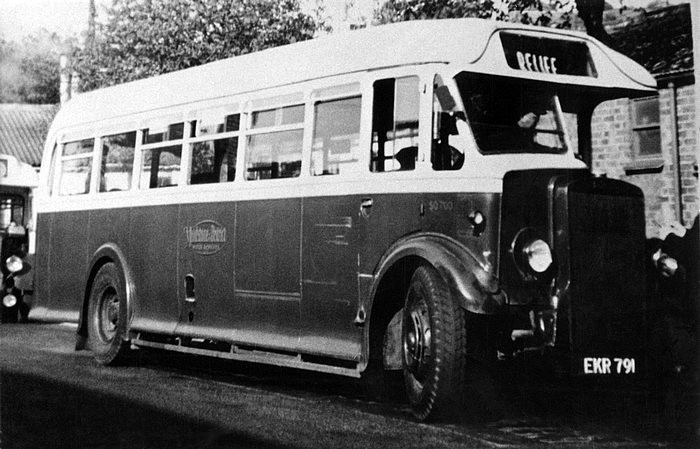
SO700 on relief bus duties on the 1950s. Photo: M. and D. and East Kent bus club. Richard Bourne
tells me it is seen in Globe Lane, Chatham, a well-used haven for buses between duties for many years.
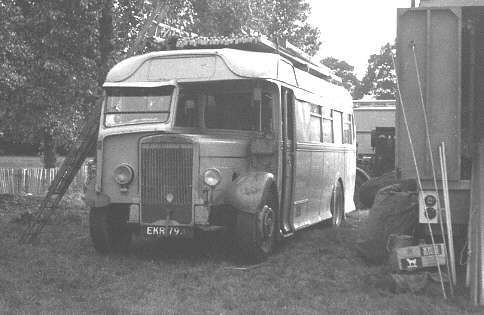
SO702 seen at Lindfield, West Sussex in August 1962 when serving with showmen after its retirement.
Photograph kindly supplied by Nigel Lemon.
- 700 (EKR 791) c/n 17821. To Royal Navy as ambulance 6/41. Returned 31/3/48. Completely rebuilt by M and D 9/48. Renumbered SO700 in 1950. To British Transport Commission 5/54. With British Railways (Western Region), number 204W.
- 701 (EKR 792) c/n 17822. To Royal Navy as ambulance 6/41. Re-registered as 9676 RN, used at Chatham Dockyard with wooden seats from 11/45. Withdrawn 4/56 and for sale by MoS at Ruddington 6/56.
- 702 (EKR 793) c/n 17823. To Royal Navy as ambulance 6/41. Returned 31/3/48. Completely rebuilt by M and D 9/48. Renumbered SO702 in 1950. To British Transport Commission 5/54. With British Railways (Western Region), number 204W at Reading 9/54 and Oxford 3/61. Believed broken up by McKeown (showman) 1965.
- 703 (EKR 794) c/n 17824. To B36F 12/41, back to B34F 8/53. To Passenger Vehicle Disposals, Dunchurch 8/55.
- 704 (EKR 795) c/n 17825. To B36F 12/41, back to B34F 10/51. To Passenger Vehicle Disposals, Dunchurch 8/55. With Aston (dealer), Marton 5/57. With showman, Hampstead 3/59.
- 705 (EKR 796) c/n 17826. To B36F 12/41, back to B34F 7/52. Broken up 1/55.
- 706 (EKR 797) c/n 17827. To B36F 12/41, back to B34F 3/52. Broken up 3/55.
- 707 (EKR 798) c/n 17828. Withdrawn 1955. Some reports say it was broken up 6/55, but also reported in use in Doncaster area 1959.
- 708 (EKR 799) c/n 17829. To B36F 11/41, back to B34F 10/51. Withdrawn 1955. With Turriff (contractor), Winfrith Heath 11/58. Fleet Car Sales, Dunchurch 2/60. Derelict at Aston (dealer), Marton 8/60.
LEYLAND TIGER TS8 BUSES - SO 709-742 (Total 34)
Delivered March-April 1939
Chassis: Leyland Tiger TS8 (8.6 litre 6-cylinder oil engines).
Body: Eastern Coach Works B34R half-canopy.
Notes; Renumbered SO709-742 in 1950. All gone by 1956.
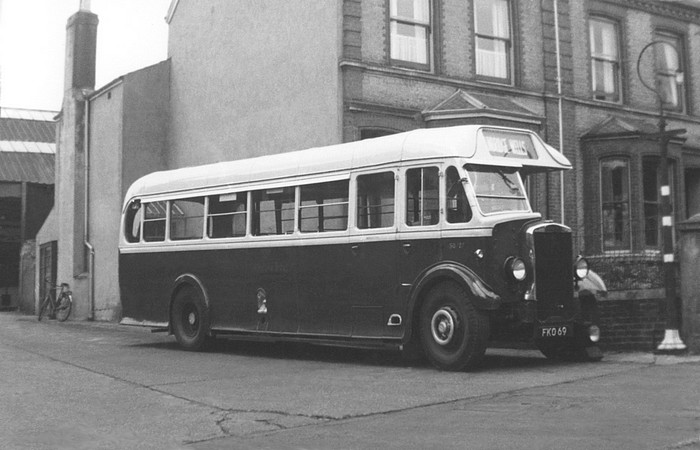
SO727 (FKO 69) in the 1950s with Tunbridge Wells on its blind. Ross Maxwell says it looks as
though the picture was taken at the Woodbury Park Road side entrance to the Tunbridge Wells garage. However Eddy Gutteridge
thinks it was taken at Gillingham Depot, Nelson Road. This batch were the only M and D Tigers with Eastern Coach Works bodies,
although the style was virtually indistinguishable from contemporary products acquired from other coachbuilders.
Photo: by kind permission of the Maidstone and District and East Kent Bus Club.
Garth Wyver says: I too feel that the location of this photo is Tunbridge Wells. I visited this
garage in the late 50s from Gravesend. I can see a likeness to Gillingham Nelson Road but looking at a photo by Keith Harwood
of DH519, GL depot has a brick gable end. Also SO727 is a Gravesend garaged bus. Who knows? It's all good fun!
John Humphrey is convinced it's at Tunbridge Wells and not Gillingham. He says: I paid a visit
recently to the position on the other side of the road where the photographer would have been standing. The Tiger had probably
deputised for a double decker on the 122 route on a diagram that finished at Tunbridge Wells, or had run as a relief as far as
Tunbridge Wells on a busy day.
Perhaps (hopefully!) the last word on this goes to Garth Wyver again, who says: I have visited R
oyal Tunbridge Wells via Google Earth. I can confirm that SO727 is standing in the driveway at the rear of M and D TW garage. The
house in the picture is 6 Woodbury Park Road. So that's settled! Thanks to all for their comments. Sadly the whole Tunbridge
Wells depot has now been demolished, but the houses on the right are still standing.
Postscript: My faithful correspondent Garth Wyver sadly passed away in late
2019. He had been sending me photos and comments from Australia for years and we used to chat endlessly about his love of East
Kent Road Car from his younger days in the UK. I miss Garth and I'm glad that his name crops up all over this website, and will
continue to do so for ever.
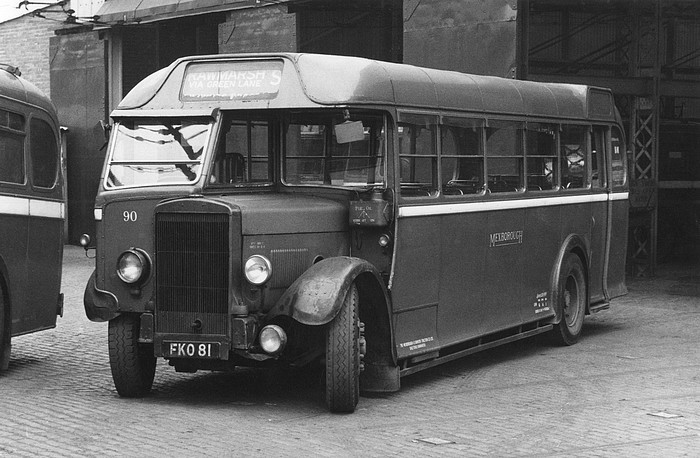
Mexborough and Swinton bought just one of this batch in 1955, when SO739 (FKO 81) became their no. 90.
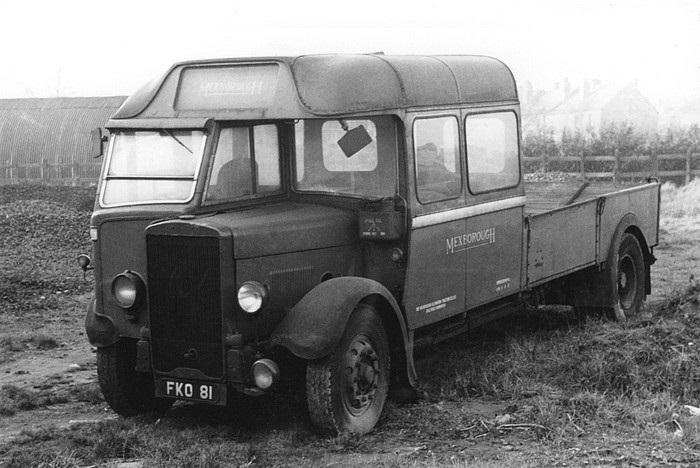
After four years in revenue service, it was retired in 1959 and converted to recovery vehicle B90,
as shown above. Both pictures by John Fozard, Keighley, West Yorkshire, via the M. and D. and East Kent bus club.
- 709 (FKO 51) - c/n 301881, b/n 5822. To Passenger Vehicle Disposals, Dunchurch 10/55. With Richards Bros, Moylgrove 5/58.
- 710 (FKO 52) - c/n 301882, b/n 5823. To Passenger Vehicle Disposals, Dunchurch 8/55. With W. Everett, South Kirby 1956, with Blamires (dealer), Bradford 5/57.
- 711 (FKO 53) - c/n 301883, b/n 5825. Broken up at Bulverythe 5/55.
- 712 (FKO 54) - c/n 301884, b/n 5824. To British Railways (N. E. Region) 10/54, as ELB0105.
- 713 (FKO 55) - c/n 301885, b/n 5826. To British Railways (Western Region) 12/54, as W220D based Windsor. To Say, Gloucester 7/58, scrapped 7/59.
- 714 (FKO 56) - c/n 301886, b/n 5827. Broken up at Bulverythe 5/55.
- 715 (FKO 57) - c/n 301887, b/n 5829. To Passenger Vehicle Disposals, Dunchurch 10/55. With Gleeson (contractor) 11/56, withdrawn 5/58.
- 716 (FKO 58) - c/n 301888, b/n 5830. To Passenger Vehicle Disposals, Dunchurch 8/55. With Lamb (contractor), Watford 1/57. With Wimpey (contractor) 10/57 as No.91. Seen with showman Wormwood Scrubs 5/58 and Welwyn Garden City 8/59.
- 717 (FKO 59) - c/n 301889, b/n 5828. To Passenger Vehicle Disposals, Dunchurch 10/55. With P. W. Wilkins, Torquay 11/55 as caravan.
- 718 (FKO 60) - c/n 301890, b/n 5831. Broken up at Bulverythe 4/55.
- 719 (FKO 61) - c/n 301891, b/n 5833. In use as office at Leysdown from 8/53 to 10/57. To Passenger Vehicle Disposals, Dunchurch 1/58. With Colbro (dealer), Rothwell 2/58. Seen on site near Rotherham 8/63.
- 720 (FKO 62) - c/n 301892, b/n 5832. Broken up at Bulverythe 6/55.
- 721 (FKO 63) - c/n 301893, b/n 5834. To Passenger Vehicle Disposals, Dunchurch 8/55. With Mitchell (contractor), Bedford 3/56.
- 722 (FKO 64) - c/n 301894, b/n 5835. To British Railways (N. E. Region) 6/55, based Tunsford 7/56 to 5/61.
- 723 (FKO 65) - c/n 301895, b/n 5836. Broken up at Bulverythe 5/55.
- 724 (FKO 66) - c/n 301896, b/n 5837. Broken up at Bulverythe 5/55.
- 725 (FKO 67) - c/n 301897, b/n 5839. Broken up at Bulverythe 7/55.
- 726 (FKO 68) - c/n 301898, b/n 5838. To British Railways (Eastern Region) 11/54, as ELB0101, based Stratford District Engineers Dept 3/57.
- 727 (FKO 69) - c/n 301899, b/n 5840. Broken up at Bulverythe 6/55.
- 728 (FKO 70) - c/n 301900, b/n 5841. To Passenger Vehicle Disposals, Dunchurch 10/55. With Knottler and Heron (contractor) 8/56.
- 729 (FKO 71) - c/n 301901, b/n 5846. To British Railways (N. E. Region) 10/54, as ELB0103.
- 730 (FKO 72) - c/n 301902, b/n 5842. Broken up at Bulverythe 7/55.
- 731 (FKO 73) - c/n 301903, b/n 5844. To British Railways (N. E. Region) Civil Engineers Dept, York 10/54, as ELB0106.
- 732 (FKO 74) - c/n 301904, b/n 5843. Broken up at Bulverythe 3/55.
- 733 (FKO 75) - c/n 301905, b/n 5848. To British Railways (N. E. Region) 6/55, still with them 9/61.
- 734 (FKO 76) - c/n 301906, b/n 5845. To British Railways (N. E. Region) Civil Engineers Dept, York 10/54, as ELB0107.
- 735 (FKO 77) - c/n 301907, b/n 5847. To Passenger Vehicle Disposals, Dunchurch 8/55. With Baillie Bros. (contractor), Birmingham 10/56.
- 736 (FKO 78) - c/n 301908, b/n 5853. To Passenger Vehicle Disposals, Dunchurch 8/55. With Mitchell (contractor), Sheffield 5/56, still with them 6/59.
- 737 (FKO 79) - c/n 301909, b/n 5849. To Passenger Vehicle Disposals, Dunchurch 10/55.
- 738 (FKO 80) - c/n 301910, b/n 5854. Broken up at Bulverythe 3/55.
- 739 (FKO 81) - c/n 301911, b/n 5852. Sold 5/55 to Mexborough and Swinton as their no. 90. Converted in 1959 into an emergency vehicle and numbered B90. Scrapped 4/67.
- 740 (FKO 82) - c/n 301912, b/n 5850. To Passenger Vehicle Disposals, Dunchurch 10/55. With Taylor, Bicester 1955-56, to E. W. Thomas, Upper Llandwrog 8/56.
- 741 (FKO 83) - c/n 301913, b/n 5851. To Passenger Vehicle Disposals, Dunchurch 10/55.
- 742 (FKO 84) - c/n 301914, b/n 5855. Broken up at Bulverythe 3/55.
TIGER TS7 / BEADLE COACHES - CO301 to 303 (Total 3)
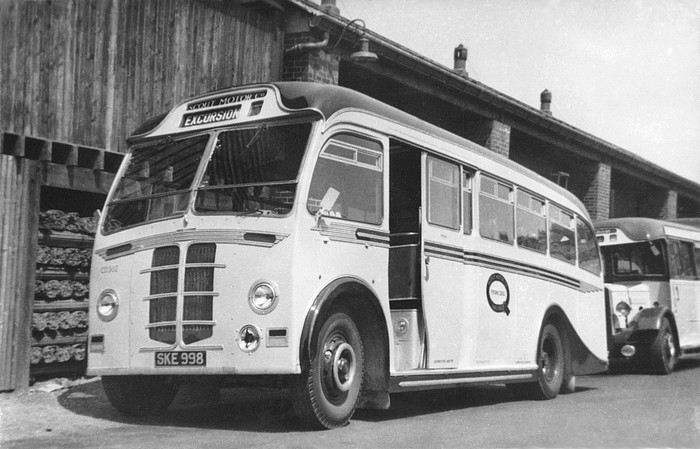
Here is Scout Motor Co. CO302 (SKE 998), basking in the sunshine in its cream and red livery,
sometime in the late 1950s and possibly at Hastings. It retired to Ireland in the 1960s. Photographer unknown.
Built Feb/Mar 1954.
Chassis: Leyland Tiger TS7 8.6 litre 6-cylinder oil engine running units from SO532-552 (see batch
details above) incorporated into a Beadle semi-chassisless structure.
Body: Beadle-Leyland C26F integral body.
Notes: 301 and 302 wore the fleet name Scout and were painted red and cream.
- CO301 (SKE 997) c/n JCB354. Used running units of former SO540 (DKL 587). To Fleet Car Sales, Dunchurch 10/61. To B. Ellis Coaches, Barking, Essex in 12/61. To SLCC (dealer) 4/64.
- CO302 (SKE 998) c/n JCB355. Used running units of former SO542 (DKL 589). To Fleet Car Sales, Dunchurch 10/61 and in use as an office there 12/61. With Herlihy Tours, Cork, Ireland in 1963. In poor condition, Killarney 1969.
- CO303 (SKE 999) c/n JCB356. Used running units of former SO 541 (DKL 588). Sometimes used on OMO work. To Fleet Car Sales, Dunchurch 6/61. To Revel Furniture Centre, Hackney, London 9/61, and used as a mobile showroom. Still with them 7/62.
Total 202 ( with 3 survivors - 665, 553 and 558 )
For more Maidstone and District buses see the AEC
Regals page.
For many other buses, have a look at all the other profiles on the Classic
Buses menu page.
SOME LINKS WITHIN THIS WEBSITE:
Home
Email
Links
THE COMPLETE WEBSITE MENU
Events Diary
Halfcab list
Small-Ads
Classic Irish Buses
Classic Manx Buses
SB



















